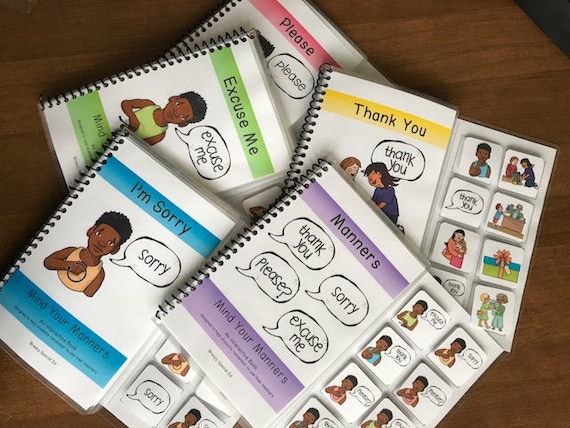One way I make differentiating easier for each student is by incorporating binders.
I separate the work for each station with labeled tabs. What's great about this system is I usually put work in their binders for several weeks at a time, so it is ready to go and I don't even have to think about it until we start to run out. Also, if several students are working together at the same station at different levels, no students are singled out and given the wrong work.
Math Binder Work: For our math station, I have students work on the topic of the day in a hands-on way first. Each shelf next to where we store the binders contains the math activities for a certain topic that corresponds with these math life skill worksheets.
For example, the worksheet below works on more/less, so the students would work with groups of manipulatives counting and choosing which one has more or which one has less or will complete some of these task cards. Then they would each finish the worksheet in their binder that is at their level.
Other math topics include money, time, directions, and sizes.
Each day of the week is a new topic. So we review money on Monday, directions on Tuesday, more/less on Wednesday, sizes on Thursday, and time on Friday. If a student masters a certain level for a topic, I move them up to the next level for that topic.
Journal Binder Work: I use these differentiated journals which I love because literally every single student in my class is able to complete these and they are all journaling about the same topic.

When completing their journals, all students need to first either color or draw the picture. This is a great time to work on skills such as color matching, copying, and problem solving ("We don't have markers here, where can you get them?" or "Your classmate is using the color you need, what do you do?" Then they read the title, and my device users find it on their device or type it out. All students then use the sentence starters to complete the sentences. My higher level writers might also add a sentence of their own at the bottom. Any students who finish quickly can also type out their journals.
(These other journals are great for higher level students and also have three levels).
Language Binder Work: This station is a little different, as it really isn't a group station. However, having the work ready to go in binders helps staff know where the students are at and keeps materials in an easily accessible location. I am always collecting data at the language station as we work on IEP goals during this time.
If my students are able to recognize some words or word shapes, I have them work through the Edmark Functional Word Series (amazon affiliate link). I love the predicability of this program and see results with my students!
Unfortunately, it isn't shaded in in the example above, but I love the progress graph attached to the data sheet so students can help track their progress!
Since incorporating these binders the amount of prep work I had to go went down considerably, as all I had to do when I noticed we were getting low on papers was just print more out! And I know that my students are getting the practice they need, with the level of support they require. Do you use station binders in your classroom?


















This is great information! I am adding a life skills component to my Deaf/Hard of Hearing program this year. Do you use one binder per student for all the stations, or do you use a separate binder for each station?
ReplyDelete!!!
ReplyDeleteThis comment has been removed by a blog administrator.
ReplyDeleteThank you so much for this great information.
ReplyDeleteHi!
ReplyDeleteI am trying to figure out how to get everything into our short 40 minute math period. I like the idea of reviewing a functional skill each day of the week. I need to teach the math curriculum and functional math. Do you have an aide oversee this station with the binders while you are teaching out of your main math curriculum? Or are these binders considered independent work?
Thanks!
I have been looking at starting station binders for different subjects to help me stay organized and differentiate for my diverse group of students. Since my math and ELA segments seem so short because of all of the different levels I have to cram in, I think this could benefit both myself and my students. Do you typically oversee each station or are they independent work while you're teaching others?
ReplyDeleteIt depends on the student and the work completed in the station but it can definitely be done independently if it is review work and the student is taught how to complete the work in the station. With the needs of my students, I would usually have a paraprofessional help teach the binder work station because that's what worked best with my classroom and our needs. Hope that helps!
Delete